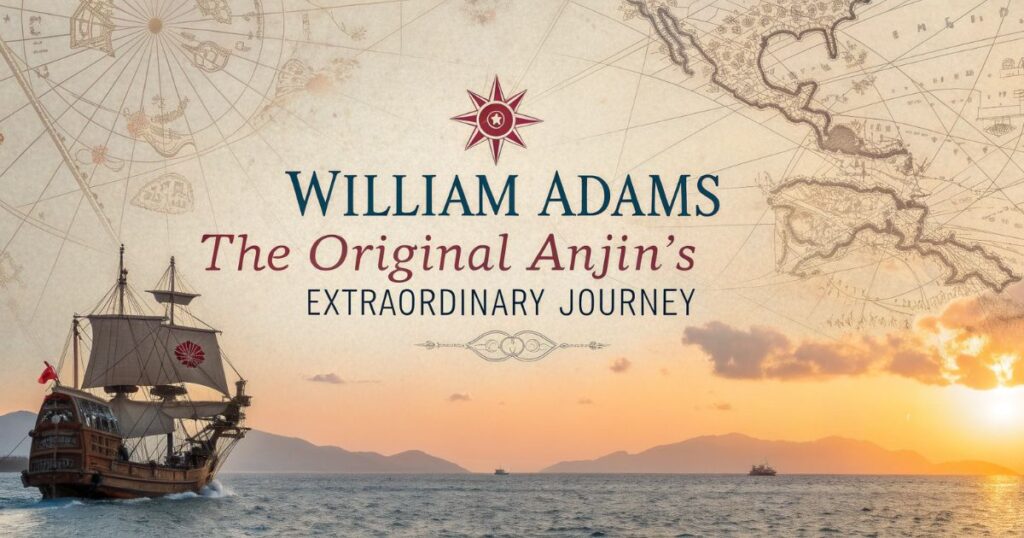The term anjin carries profound historical weight that bridges two vastly different cultures across four centuries.
This Japanese word, meaning “pilot” or “navigator,” became forever linked with one extraordinary Englishman’s unprecedented journey into the heart of feudal Japan.
Understanding anjin opens a window into cultural adaptation, resilience, and the timeless human capacity to build bridges across seemingly impossible divides.
The Etymology Unveiled: What Does Anjin Actually Mean?
Anjin (按針) translates directly to “pilot” or “navigator” in Japanese. However, this simple translation barely scratches the surface of its cultural significance.
The kanji characters reveal deeper meaning. An (按) means “to guide” or “to press,” while jin (針) refers to a needle or compass point. Together, they create a beautiful metaphor for someone who guides using precision instruments.
Originally, anjin described maritime professionals who navigated ships through treacherous waters. These skilled individuals possessed intimate knowledge of currents, weather patterns, and coastal landmarks.
The term evolved beyond nautical contexts to represent anyone who guides others through unfamiliar territory. This broader interpretation makes anjin particularly resonant in our interconnected world.
William Adams: The Original Anjin’s Extraordinary Journey

William Adams arrived in Japan by pure accident in 1600. His Dutch ship, the Liefde, limped into Bungo harbor after a catastrophic Pacific crossing that claimed most of the crew.
Japan was virtually sealed from the outside world. The sakoku isolationist policy made foreign contact extremely limited and often dangerous for outsiders.
Adams faced immediate suspicion. Portuguese Jesuit missionaries, already established in Japan, viewed him as a Protestant threat. They actively lobbied for his execution.
Tokugawa Ieyasu, the future shogun, saw something different in Adams. The Englishman’s knowledge of shipbuilding, navigation, and Western military tactics proved invaluable.
Within months, Adams transformed from prisoner to advisor. His mathematical skills and practical engineering knowledge impressed Japanese officials who were eager to modernize their military capabilities.
The ultimate honor came when Tokugawa granted Adams samurai status – something no Westerner had ever achieved. He received a Japanese name, Miura Anjin, and land holdings typically reserved for noble families.
Adams married a Japanese woman and started a family. He learned the language fluently and adapted to Japanese customs while maintaining his English identity.
His dual cultural perspective made him an invaluable diplomatic bridge. Adams facilitated trade negotiations and cultural exchanges that benefited both nations.
Shogun’s Anjin: James Clavell’s Literary Masterpiece Impact
James Clavell’s 1975 novel “Shogun” introduced millions of Americans to the anjin story. The book became a cultural phenomenon, spending weeks on bestseller lists.
Clavell fictionalized Adams as John Blackthorne, maintaining the core historical elements while adding dramatic tension. The author researched extensively, creating an authentic portrayal of 17th-century Japanese society.
The novel’s success stemmed from its cross-cultural narrative. American readers connected with Blackthorne’s fish-out-of-water experience while being fascinated by Japanese customs.
Historical accuracy remained surprisingly high throughout most of the story. Clavell consulted Japanese historians and cultural experts to ensure authenticity.
The book sparked widespread American interest in Japanese history and culture. Many readers began studying Japanese language and philosophy after finishing “Shogun.”
Modern Media Renaissance
The 2024 FX/Hulu series “Shogun” brought the anjin story to a new generation. This adaptation prioritized historical accuracy over previous versions.
Cosmo Jarvis’s portrayal of John Blackthorne earned critical acclaim for its nuanced performance. The actor spent months learning Japanese and studying samurai culture.
Production teams worked closely with Japanese cultural consultants to ensure authentic representation. This attention to detail resonated strongly with both American and Japanese audiences.
Streaming platforms reported record viewership numbers. The series generated over 18 million views in its first month, demonstrating enduring fascination with the anjin narrative.
Social media discussions highlighted renewed interest in Japanese history among American viewers. Educational institutions reported increased enrollment in Japanese language courses following the series premiere.
Cultural Symbolism: Anjin as Metaphorical Bridge-Builder
Modern anjin symbolism extends far beyond historical maritime contexts. The term represents skillful navigation through cultural differences and unfamiliar social territories.
International businesses frequently reference anjin principles when training employees for overseas assignments. The concept emphasizes adaptation while maintaining core identity values.
Educational programs use anjin metaphors to teach cultural sensitivity. Students learn to approach foreign cultures with respect, curiosity, and willingness to adapt.
Personal development coaches employ anjin concepts for individuals facing major life transitions. The historical model provides inspiration for navigating uncertain circumstances.
Digital nomads and remote workers particularly connect with anjin symbolism. These modern professionals must constantly adapt to new environments while maintaining professional effectiveness.
Japanese Language Learning
Anjin appears regularly in modern Japanese conversation, though primarily in specific contexts. Maritime industries still use the term for professional pilots and navigators.
Academic settings frequently employ anjin when discussing historical periods or literature. The word carries educational weight beyond its literal meaning.
Popular culture references include anime, manga, and video games featuring navigation themes. These media help maintain the term’s cultural relevance among younger generations.
Pronunciation for American English speakers follows standard Japanese phonetic rules: “AHN-jin” with equal emphasis on both syllables.
Language learning applications often include anjin in intermediate vocabulary lessons due to its historical and cultural significance.
Associated Historical Concepts and Context
The sakoku period (1633-1853) created the isolated environment that made Adams’s story so remarkable. This isolationist policy severely limited foreign contact for over two centuries.
Tokugawa shogunate political structure centralized power under military leadership. This system valued practical skills and loyalty above traditional aristocratic bloodlines.
Dutch East India Company maintained Japan’s primary Western trade relationship during this period. Their commercial activities provided the context for Adams’s initial arrival.
Christian missionary tensions significantly impacted foreign relations. Portuguese and Spanish missionaries faced increasing persecution, making Protestant Adams’s acceptance more remarkable.
Samurai class hierarchy traditionally excluded outsiders completely. Adams’s integration represented an unprecedented social transformation.
The Anjin Mindset
Adaptability forms the core of anjin philosophy. This approach emphasizes flexible thinking while maintaining personal integrity and values.
Resilience through adversity characterizes the anjin spirit. Historical examples demonstrate how individuals can thrive despite overwhelming challenges.
Cultural diplomacy requires understanding rather than domination. The anjin approach builds trust through genuine respect and mutual benefit.
Leadership effectiveness increases when leaders adopt anjin principles. These concepts emphasize service, learning, and collaborative problem-solving.
Modern applications include international relations, business negotiations, and community building initiatives across cultural boundaries.
Similar Historical Figures
Marco Polo represents an earlier example of successful cultural bridge-building. However, his experience lacked the deep integration that characterized Adams’s story.
Lafcadio Hearn (Koizumi Yakumo) achieved similar cultural assimilation in late 19th-century Japan. His literary work helped introduce Japanese culture to Western audiences.
Contemporary examples include modern cultural ambassadors who facilitate international understanding through various professional and artistic endeavors.
Historical contexts vary significantly, but successful cultural integration requires consistent elements: respect, patience, and genuine interest in understanding foreign perspectives.
Effective relationship building across cultures demands long-term commitment and willingness to challenge personal assumptions about foreign customs and values.
Educational and Cultural Resources
Recommended reading includes “The English Samurai” by William Corr and “Samurai William” by Giles Milton for historically accurate accounts.
Documentary films such as “The Real Anjin” provide visual context for Adams’s remarkable story and its historical significance.
Museum exhibitions at institutions like the Peabody Essex Museum showcase artifacts from early Japanese-American cultural exchanges.
Language learning resources include NHK World’s Japanese lessons and university-level courses focusing on historical and cultural contexts.
Travel opportunities exist for visiting historical sites in Japan, including Miura Peninsula locations associated with Adams’s life there.
FAQs
1. What does “Anjin” mean in Japanese, and where does the term come from?
“Anjin” (written 安針) is a Japanese word meaning “pilot” or “navigator,” especially in a maritime sense.
It became famously used as a title for the English navigator William Adams when he was in Japan—he was granted the name Miura Anjin, meaning “pilot of Miura.”
2. Who was William Adams and how did “Anjin” become associated with him?
William Adams was an English sailor who arrived in Japan in the early 1600s and gained favor with the shogunate for his skills in navigation and shipbuilding.
He was given the Japanese title Miura Anjin, with “Anjin” referring to his role as a pilot or navigator, and “Miura” being a location (Miura Peninsula).
3. How has “Anjin” been used in literature and modern popular culture?
The term “Anjin” features prominently in Shōgun, the novel by James Clavell, and its tv/film adaptations, as the name used by Japanese characters for John Blackthorne, based loosely on William Adams.
In those works, “Anjin” underscores Blackthorne’s position as navigator/pilot and also acts as a symbol of his identity in Japan.
Conclusion
Anjin represents far more than a simple Japanese word for navigator – it embodies the timeless human capacity to build meaningful connections across cultural divides.
William Adams’s extraordinary transformation from shipwrecked sailor to trusted samurai advisor demonstrates how authentic cultural exchange can transcend seemingly impossible barriers.
Today’s interconnected world desperately needs individuals willing to embrace the anjin spirit: approaching foreign cultures with respect, curiosity, and genuine commitment to mutual understanding.
More Posts
To No Avail: Meaning, Examples, and Similar Phrases
Perdition Meaning: The Complete Guide to Understanding and Use
Habibti Meaning: Definition, Common Usage, and Synonyms

Welcome to Brightnis! I am the admin and creator of this platform. I love questioning ideas and exploring different situations. My goal is to encourage critical thinking and help people see things from new perspectives. Join me in discussing thought-provoking topics and finding unique solutions to everyday challenges!
















